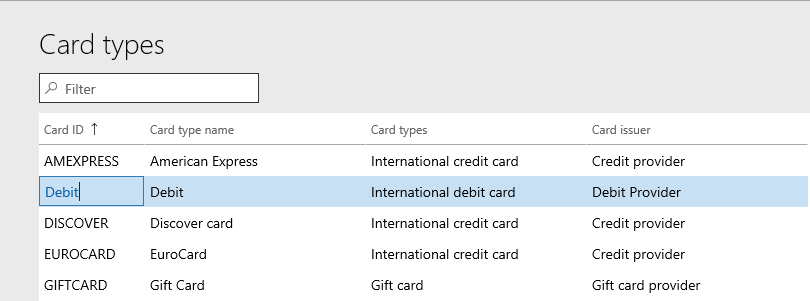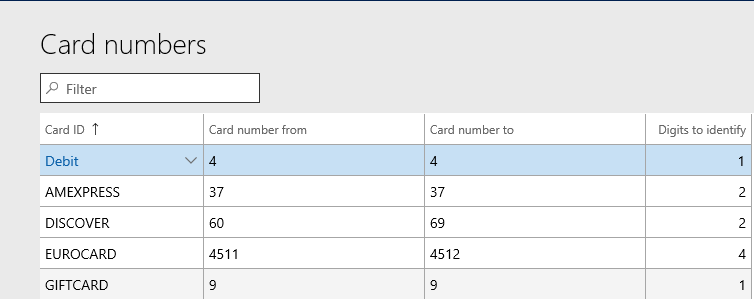Card types
|
🛈 Important This topic applies only when processing payments using Point of sale and e-Commerce (Online channel) |
First, create the Card types that will match the Payment methods that your store will accept.
These will mirror the accepted forms of payment that are setup on the Provider side.
Create Card types
Navigate to Retail and commerce > Channel setup > Payment methods > Card types
Specify all fields

Creating a card number against a Card type
Navigate to Retail and commerce > Channel setup > Payment methods > Card numbers
Specify the Card number from and Card number to Digits to identify the card.
Refer to the following screenshot:

There must be a card type VISA with the following Card numbers values:
Card number from: 4
Card number to: 4
Digits to identify: 1
Configuring the card types for Retail stores
Navigate to: Retail and commerce > Channels > Retail stores > All retail stores
Select the respective Store > and go to Set up > Set up > Payment methods > Select payment method “card” > go to Card setup > create new Card setup > Select created Card type from drop down and enter the required values as per your requirements.

Configuring the card types for Online channels
Navigate to: Retail and commerce > Channels > Online stores > All online stores
Select the respective Store > and go to Set up > Set up > Payment methods > Select payment method “card” > go to Card setup > create new Card setup > Select created Card type from drop down and select the Card type to suit your requirements.

Card mapping explained
Card mapping provides a mechanism whereby the card types (Codes) as identified by the Payment Provider are mapped to those in
An example mapping string is as follows:
AX:AMEXPRESS;DB:Debit;DC:VISA;GC:GIFTCARD;JC:VISA;MC:MASTER;NS:VISA;PL:VISA;SC:VISA;SR:VISA;VS:VISA;YC:VISA;
A default is provided when you create a new Payment profile - and you can use this to edit for your specific requirement. It is recommended to use a text editor to edit this string, and to always keep a copy outside of Dynamics 365 for reference and backup purposes.
The string format is as follows:
Format: "XX:YYYYY;"
Where
XX is the two digit code that is passed to MAX Pay from the Payment Provider
YYYYY is the variable length code that exists within Dynamics 365.
A semi colon separates each mapped pair.
Example:
MC: MASTER;
MC: This is the card type code that is returned by the Payment Provider, whilst performing a transaction.
Do not edit this. This code will not change.
MASTER: This is how Dynamics 365 refers to a MASTER card type.

Default code
The Default code (left of the colon) enables the use of a catch-all. This allows all unmapped card types returned from the Payment provider, to fall into one card type bucket. For example - if we set the mapping to include:
Default:VISA
The above would map all unknown types and record the transactions as VISA.
Jobs
Once you have completed the above configuration, run the 1070 and 1090 Jobs.